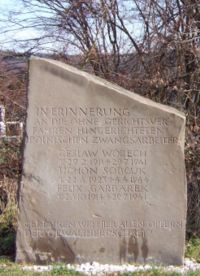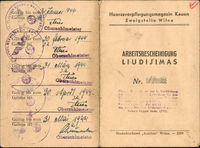
Arbeitseinsatz
Encyclopedia


Arbeitseinsatz was forced labour (Zwangsarbeit) during World War II
Forced labor in Germany during World War II
The use of forced labour in Nazi Germany and throughout German-occupied Europe during World War II took place on an unprecedented scale. It was a vital part of the German economic exploitation of conquered territories. It also contributed to the mass extermination of populations in German-occupied...
when German men were called up
Conscription
Conscription is the compulsory enlistment of people in some sort of national service, most often military service. Conscription dates back to antiquity and continues in some countries to the present day under various names...
for military service and German authorities rounded up labourers, some from Germany but more from the occupied territories, to fill in the vacancies. Arbeitseinsatz was not restricted to the industry sector and to arms factories; it also took place, for example, in the farming sector
Agriculture
Agriculture is the cultivation of animals, plants, fungi and other life forms for food, fiber, and other products used to sustain life. Agriculture was the key implement in the rise of sedentary human civilization, whereby farming of domesticated species created food surpluses that nurtured the...
, community services, and even in the churches. There were many affected populations, who can be grouped by various (often overlapping) variables (such as geographic, ethnic
Ethnic group
An ethnic group is a group of people whose members identify with each other, through a common heritage, often consisting of a common language, a common culture and/or an ideology that stresses common ancestry or endogamy...
, religious, political, and medical). They included political prisoner
Political prisoner
According to the Longman Dictionary of Contemporary English, a political prisoner is ‘someone who is in prison because they have opposed or criticized the government of their own country’....
s of the SA
Sturmabteilung
The Sturmabteilung functioned as a paramilitary organization of the National Socialist German Workers' Party . It played a key role in Adolf Hitler's rise to power in the 1920s and 1930s...
, Gestapo
Gestapo
The Gestapo was the official secret police of Nazi Germany. Beginning on 20 April 1934, it was under the administration of the SS leader Heinrich Himmler in his position as Chief of German Police...
, and SS
Schutzstaffel
The Schutzstaffel |Sig runes]]) was a major paramilitary organization under Adolf Hitler and the Nazi Party. Built upon the Nazi ideology, the SS under Heinrich Himmler's command was responsible for many of the crimes against humanity during World War II...
; civilian
Civilian
A civilian under international humanitarian law is a person who is not a member of his or her country's armed forces or other militia. Civilians are distinct from combatants. They are afforded a degree of legal protection from the effects of war and military occupation...
men and women from occupied territories of Eastern Europe (Ostarbeiter
OST-Arbeiter
OST-Arbeiter was a designation for slave workers gathered from Eastern Europe to do forced labor in Germany during World War II. The Ostarbeiters were mostly from the territory of Reichskommissariat Ukraine . Ukrainians made up the largest portion although many Belarusians, Russians, Poles and...
); prisoners of war
Prisoner of war
A prisoner of war or enemy prisoner of war is a person, whether civilian or combatant, who is held in custody by an enemy power during or immediately after an armed conflict...
; institutionalized people (that is, mentally or physically disabled people
Disability
A disability may be physical, cognitive, mental, sensory, emotional, developmental or some combination of these.Many people would rather be referred to as a person with a disability instead of handicapped...
, or medical and psychiatric patients); and various ethnic, religious, or ethnoreligious groupings (for example, Jews
Jews
The Jews , also known as the Jewish people, are a nation and ethnoreligious group originating in the Israelites or Hebrews of the Ancient Near East. The Jewish ethnicity, nationality, and religion are strongly interrelated, as Judaism is the traditional faith of the Jewish nation...
, Sinti
Sinti
Sinti or Sinta or Sinte is the name of a Romani or Gypsy population in Europe. Traditionally nomadic, today only a small percentage of the group remains unsettled...
, Romani, Yeniche, and Jehovah's Witnesses
Jehovah's Witnesses
Jehovah's Witnesses is a millenarian restorationist Christian denomination with nontrinitarian beliefs distinct from mainstream Christianity. The religion reports worldwide membership of over 7 million adherents involved in evangelism, convention attendance of over 12 million, and annual...
). They lived in various kinds of camps, called labor camp
Labor camp
A labor camp is a simplified detention facility where inmates are forced to engage in penal labor. Labor camps have many common aspects with slavery and with prisons...
s (Arbeitslager
Arbeitslager
Arbeitslager is a German language word which means labor camp.The German government under Nazism used forced labor extensively, starting in the 1930s but most especially during World War II....
in German) and concentration camps (Konzentrationslager [KZ] in German). Nazi concentration camps
Nazi concentration camps
Nazi Germany maintained concentration camps throughout the territories it controlled. The first Nazi concentration camps set up in Germany were greatly expanded after the Reichstag fire of 1933, and were intended to hold political prisoners and opponents of the regime...
were often meant not only for forced labor but also extermination. In 1945 about 7.7 million workers in the German industry were of non-German origin. Many of them were very young, and about half of them were women.
In reports of the Warsaw Ghetto
Warsaw Ghetto
The Warsaw Ghetto was the largest of all Jewish Ghettos in Nazi-occupied Europe during World War II. It was established in the Polish capital between October and November 15, 1940, in the territory of General Government of the German-occupied Poland, with over 400,000 Jews from the vicinity...
the arbeitseinsatz is described as "voluntary" (freiwillig / free willing).

